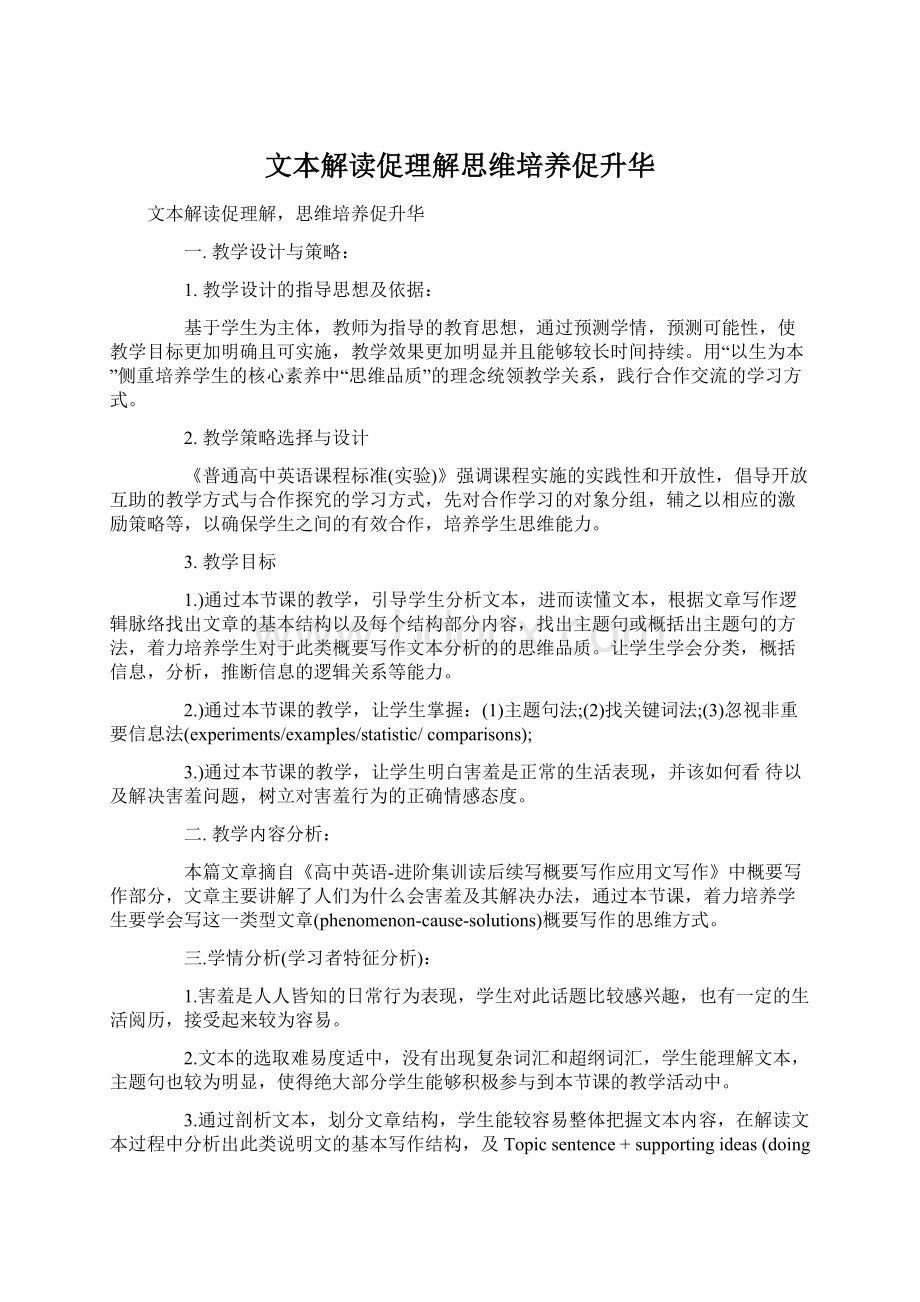文本解读促理解思维培养促升华.docx
《文本解读促理解思维培养促升华.docx》由会员分享,可在线阅读,更多相关《文本解读促理解思维培养促升华.docx(7页珍藏版)》请在冰豆网上搜索。

文本解读促理解思维培养促升华
文本解读促理解,思维培养促升华
一.教学设计与策略:
1.教学设计的指导思想及依据:
基于学生为主体,教师为指导的教育思想,通过预测学情,预测可能性,使教学目标更加明确且可实施,教学效果更加明显并且能够较长时间持续。
用“以生为本”侧重培养学生的核心素养中“思维品质”的理念统领教学关系,践行合作交流的学习方式。
2.教学策略选择与设计
《普通高中英语课程标准(实验)》强调课程实施的实践性和开放性,倡导开放互助的教学方式与合作探究的学习方式,先对合作学习的对象分组,辅之以相应的激励策略等,以确保学生之间的有效合作,培养学生思维能力。
3.教学目标
1.)通过本节课的教学,引导学生分析文本,进而读懂文本,根据文章写作逻辑脉络找出文章的基本结构以及每个结构部分内容,找出主题句或概括出主题句的方法,着力培养学生对于此类概要写作文本分析的的思维品质。
让学生学会分类,概括信息,分析,推断信息的逻辑关系等能力。
2.)通过本节课的教学,让学生掌握:
(1)主题句法;
(2)找关键词法;(3)忽视非重要信息法(experiments/examples/statistic/comparisons);
3.)通过本节课的教学,让学生明白害羞是正常的生活表现,并该如何看待以及解决害羞问题,树立对害羞行为的正确情感态度。
二.教学内容分析:
本篇文章摘自《高中英语-进阶集训读后续写概要写作应用文写作》中概要写作部分,文章主要讲解了人们为什么会害羞及其解决办法,通过本节课,着力培养学生要学会写这一类型文章(phenomenon-cause-solutions)概要写作的思维方式。
三.学情分析(学习者特征分析):
1.害羞是人人皆知的日常行为表现,学生对此话题比较感兴趣,也有一定的生活阅历,接受起来较为容易。
2.文本的选取难易度适中,没有出现复杂词汇和超纲词汇,学生能理解文本,主题句也较为明显,使得绝大部分学生能够积极参与到本节课的教学活动中。
3.通过剖析文本,划分文章结构,学生能较容易整体把握文本内容,在解读文本过程中分析出此类说明文的基本写作结构,及Topicsentence+supportingideas(doingexperiments/examples/listingstatistic/makecomparisons)学生能够进一步掌握此类概要文章的写作方法,进而内化成思维模式,培养学生对于此类文章的思维品质。
四.教学重点及难点:
1.理解文本,文体,划分文本结构(phenomenon-cause-solutions)
2.找出或归纳每段落主题句。
3.解读文本,理解文本段落的组织架构,及topicsentence+supportinginformation,以及supportingideas的常用呈现形式。
五.教学过程:
Step1:
Introduction(Leadingin):
Teacher:
Withsomanyteacherssittingaroundyou?
Areyoufeelingalittlenervousandshy,don’tyou?
Student:
Yes./No.
Teacher:
Ithinkmaybemostofyoumayfeelalittlenervousandshy,butwhatdoyouknowshyness?
Whypeoplefeelshyintheirdailylifesometimes?
Areyourdeskmatesshysometimes?
Howdoyouhelphim/herovercomehis/hershyness?
Howmanypeoplefeelshyaroundyou?
Maybemostofyoudon’thaveaclearideaaboutthat.ButI’msureafterthisclass,youmaygetaclearideaaboutthosequestions.Beforewebeginourclass,I’dliketoaskanotherquestion,Imagineyouarerequestedtowriteanessayaboutshyness,howwouldyoudo?
Nowpleasediscussthequestionwithyourpartnersandthengivemeyouranswers.
Students1:
IfIwritesuchanessay,firstofall,I’dliketosurftheInternettosearchsomeinformationaboutwhypeoplefeelshy?
Then,I’dliketooffersomesuggestionsonhowtodealwiththat.
Teacher:
Arethereanyotheropinions?
Ifso,pleaseraiseyourhandstogivemeyouropinion.
Students2:
I’dliketowritetowritewhattheshynessisinthebeginning,thenwhypeoplefeelshy.Atlast,Ialsowilloffersomepracticalsolutionstodowithit.
Teacher:
Ok,sogoodideasyouoffered.Thankyousomuch,smartboys.Nowpleaseskimthepassageandfinishthequestionsonpapersheet.
设计意图:
(通过话题引入,让学生思考如何写此类文章,学生可以通过思考大概会想出此类文本的写作思路和流程,为接下来的教学奠定基础)
Step2:
Skimthepassageandthinkwhatthewritingstyleis.
Teacher:
Haveyoufinishyourreading?
Pleasetellmewhatthewritingstyleofthepassage.Isitanexposition,anarration,oranargumentation?
Students:
It’sanexposition.
Teacher:
Isthereanydifferentopinion?
Students:
No,we’reveryclearaboutthat.
Teacher:
Ok,fantastic.Youhavedoneagoodjob.Now,readthepassageagain,andtrytoclarifythestructureofthepassage.
设计意图:
(通过快速阅读文章,确定文章文体,从整体上把握文章,以对比学生自己合作学习的成果,给予学生自我启发)
Step3:
Readthepassageagainandtrytofigureoutthestructureofthepassage.
Teacher:
Finishyourreading?
Pleasetellmethestructureofthepassageinyouropinion,orinotherwords,howmanypartscanbelogicallydivided.
Students:
Itcanbedividedintothreeparts.
Teacher:
ifitcanbedividedintothreeparts,whatarethey?
Thinkaboutthat,meanwhileyoucandiscusswithyourdeskmate.Iwillaskyoutoanswerthat.
Students:
Partoneshouldbethefirstparagraph.Parttwomayconsistsofthreeparagraphs,that’stosay,paragraph2toparagraph4.Andpartthreeshouldbethelastparagraph.
Teacher:
whydoyouthinkso?
I’dliketoaskonestudenttoanswer.
Student1:
Becauseparagraph1mainlytalksaboutthepresentsituationofshyness.Andparagraph2to4mainlytalksaboutthereasonsforone’sshyness.Paragraph5talksaboutthesolutions.
Teacher:
ok,fantastic.Youhavedoneagoodjob.
设计意图:
(再次阅读文章,联系step1部分让学生讨论的文章结构,可以使学生更好的整体把握,完成对文章主体结构的划分,使学生更好的理解文章,为接下来的文本解读奠定基础,把学生引入到phenomenon-cause-solutions,使得他们能自己总结出来。
)
Step4:
FindouttheTCofeachparagraph.(Payattentiontothesignalwords)文本解读:
Teacher:
Ok,allofyouaresoclever,I’msodelighted.Youhavealreadyfoundoutthestructureofthepassage,whichIthinkisofgreathelpforyoutofindoutthetopicsentencesofeachparagraph.Nowlet’smovetostep4:
findouttheTCofeachparagraph.Ok,firstofall,I’dliketoaskyousomequestions.Youcandiscusswithyourpartnerfirstthenanswerthosequestions.
Q1:
Inyouropinion,isthereanySWwordscanbefoundaccordingtothestructure,andwhatarethey?
Q2:
WheredoTCsusuallyliesintheparagraph?
Q3:
Whatkindofwordsyoushouldpayattentiontointhisprocess(linkingwords,timesignalwords,etc.)?
Q4:
Wehavealreadyconcludedthestructuresofthepassage,sowhatyoushouldtakenoticeof?
Students:
……
Teacher:
Ok,I’msogladyoucangivemesomanygoodanswers.Now,trytousewhatyoulearnedtofindTCofeachparagraph.Whateverparagraphwillbeallright.ButIsuggestyoubeginwithpart2,part2mainlytalkedaboutreasons,somaybeyoucanfindsomesignalwords(givethem5minutes)
Students:
Givetheiranswers.MostofthemfoundtheTCofPara.2/3./4.
Teacher:
IsthereanySWofPara.1?
Trytofindthem.(学生划出了Thesedays和Nowadays,确定了这两句应该是主题句),鼓励学生用同样的方法去找第三部分Solution的主题句,学生可以发现此段的主题句和第二段的主题句都在转折连词之后,得出结论。
然后和学生一起分析文本,主题句之后的文本信息如何处理。
Forexample:
Teacher:
Howtodealwiththeotherinformationofparagraph2,whataretheyusedfor?
Isitpossibletobebornshy?
Manyscientistssayyes.Theysay15to20percentofbabiesbehaveshyly.Thesebabiesarealittlequieterandmorewatchfulthanotherbabies.Interestingly,theseshybabiesusuallyhaveshyparents.Asaresult,scientiststhinkthatsomeshynessisgenetic.
Students:
Theyareusedforsupportingthetopicsentence.Wecanseethatfromthelinkingwords(Asaresult…)
Teacher:
Yes,youareright.Butwhattheotherinformationusedfor?
Theauthorlistssomestatisticstosupporthisidea.
第二和第四段属于文章第二部分范畴,第二部分主要讲的是造成害羞的原因,所以学生可以关注文本中的能显示原因的SW,含有此类SW的句子一般都是主题句。
这样比较容易找出主题句。
本部分主要让学生回答,学生觉得第二到第四段的主题句比较好找,如第三段familysizemightcausepeopletobeshytoo.第四段中Youmayalsobeshybecauseofwhereyouwereborn.学生可以很容易找出划线的句子和本部分所述reason一致。
通过此步骤,和学生一起归纳出概括主题句所运用的小技巧;
Tip1:
payspecialtothetimesignalwordswhendoingyoursummarywriting.
Tip2:
thetopicsentenceusuallyliesinthefirstorthelastsentenceofeachparagraph.
Tip3:
leaveouttheunnecessaryorsupportinginformation(experiment/statistics/examples/comparisons)
Tip4:
payspecialtothelinkingwords
设计意图:
通过合作式的教学模式,提出问题,让学生讨论,并且老师通过问题的启发,训练学生思维能力,能够让给学生得出文本是由topicsentence+supportingideas所组成的,supportingideas的组成主要包括doingexperiment/listingstatistics/listingexamples/makingcomparisons,这样有助于学生迅速找出主题句,把握每段落的主旨大意,理解文章,为概要写作奠定基础。
六.板书设计:
1.Thestyleofthepassage:
exposition
2.Howmanypartscanbedivided?
---Fourparts
Part1(para1):
Phenomenon
Part2(para2-4):
Causes
Part3(para5):
Solutions
3.Findoutthetopicsentencesofeachparagraph.
Para1:
Nowshynessisbecomingcommonandscientistshavesomeideasaboutthereasons.
Para2:
Scientiststhinkthatsomeshynessisgenetic.
Para3:
Familysizemightcausepeopletobeshytoo.
Para4:
Youmayalsobeshybecauseofwhereyouwereborn.
Para5:
Scientistssuggesttryingnewthingsandpracticingconversation.
七.教学反思
本堂课文本选取较为简单,教师以核心素养为导向,着重学生思维品质的培养,首先通过学生自主讨论,提出问题:
如果你要写此类文章,你会怎么样写?
采取何种结构?
从而启发学生思维,这样学生基本上能够从整体的角度理解文章的篇章结构,划分层次,在老师的指导下能够推测出文本是按照phenomenon-cause-solutions的结构层次展开进而可以比较明显的看出文本可以划分为三个大的部分,我通过和学生一同探讨主题句的一般规律,使学生能够找出每个段落的主题句,为接下来的教学做铺垫;学生获得肯定后也更加积极的参与到课堂教学中,基本上实现了以学生为主体,教师起引导作用的新课改理念和目标。
在文本的解读方面,主题句的确定上我给予的指导相对多了一些,一定程度上限制了学生的思维能力,感觉是教师在指导,而非引导;而且第一段和第五段的文本在解读过程中学生确定主题句还有偏差,认为主题句或关键句只能有一句,第一段的主题为phenomenon原本比较容易看出,可是由于是借班上课,我对学情没有完全考虑到位的,学生并没有很容易找出来;另外对于supportinginformation的构成experiment/statistics/examples/comparisons的导出有些粗糙,需要进一步思考如何在课堂教学方面自然过度到此环节。
概要写作个人认为应该分为两节课来上,一节课用来解读文本,另一节课用来和学生一起探讨替换词以及选用合适连接词把文章有逻辑地联系到一起。
不知道我这个想法是否正确?
还是说如果学生基础相对较好,完全可以上成一节课的样子?
请同仁给予指导,谢谢。
附上:
概要写作原文和原本学案
经开区90学时培训公开课概要写作原文
Areyoushy?
Ifyouare,youarenotalone.Infact,closeto50percentofpeopleareshy.Almost80percentofpeoplefeelshyatsomepointintheirlives.Thesedays,shynessisbecomingmoreandmorecommon.Now,scientistsaretryingtounderstandshyness.Theyhavesomeinterestingideasaboutwhypeopleareshy.
Isitpossibletobebornshy?
Manyscientistssayyes.Theysay15to20percentofbabiesbehaveshyly.Thesebabiesarealittlequieterandmorewatchfulthanotherbabies.Interestingly,theseshybabiesusuallyhaveshyparents.Asaresult,scientiststhinkthatsomeshynessisgenetic.
Familysizemightcausepeopletobeshytoo.ScientistsatHarvardUniversitystudiedshychildren.Theyfoundthat66percentofthemhadolderbrothersandsisters.Asaresult,theybecameshy.Atthesametime,childrenwithnobrothersandsistersmaybeshyaswell.Growingupalone,theyopenplaybythemselves.Theyarenotabletolearnthesamesocialskillsaschildrenfrombigfamilies.
Youmayalsobeshybecauseofwhereyouwereborn.Whenscientistsstudiedshynessindifferentcountries,theyfoundsurprisingdifferences.InJapan,mostpeoplesaidtheywereshy.ButinIsrael,onlyoneofthreepeoplesaidso.Whatexplainsthedifferences?
OnescientistsaystheJapaneseandIsraelishavedifferentopinionsoffailure.InJapan,whenpeo